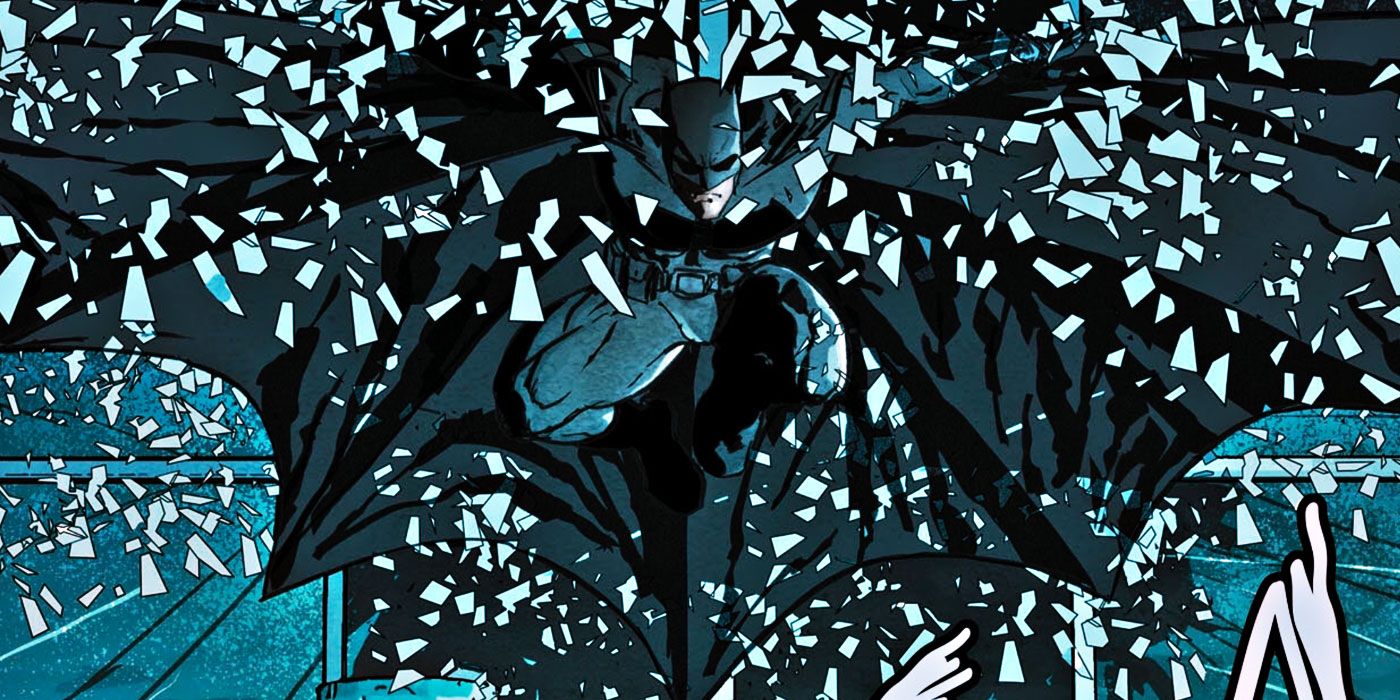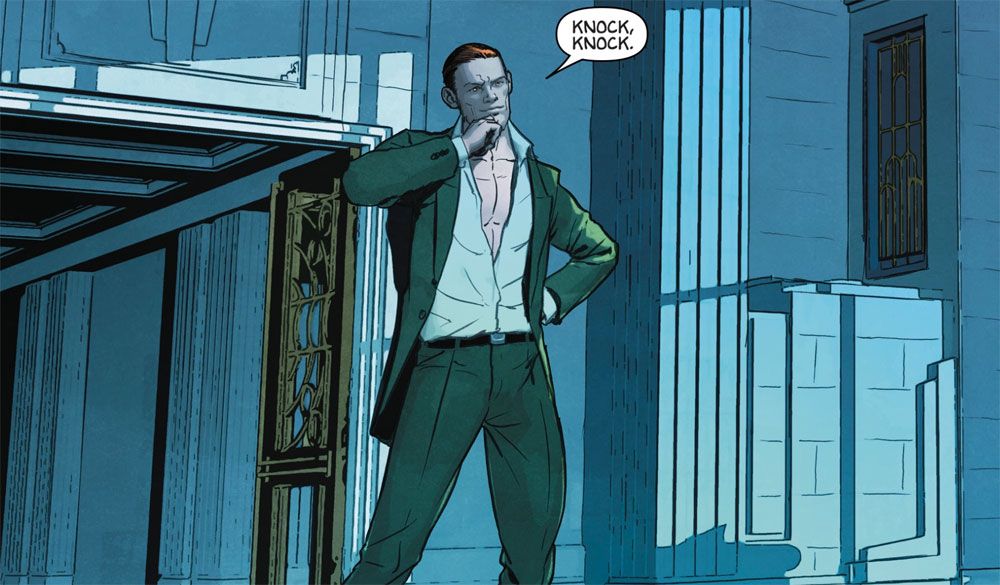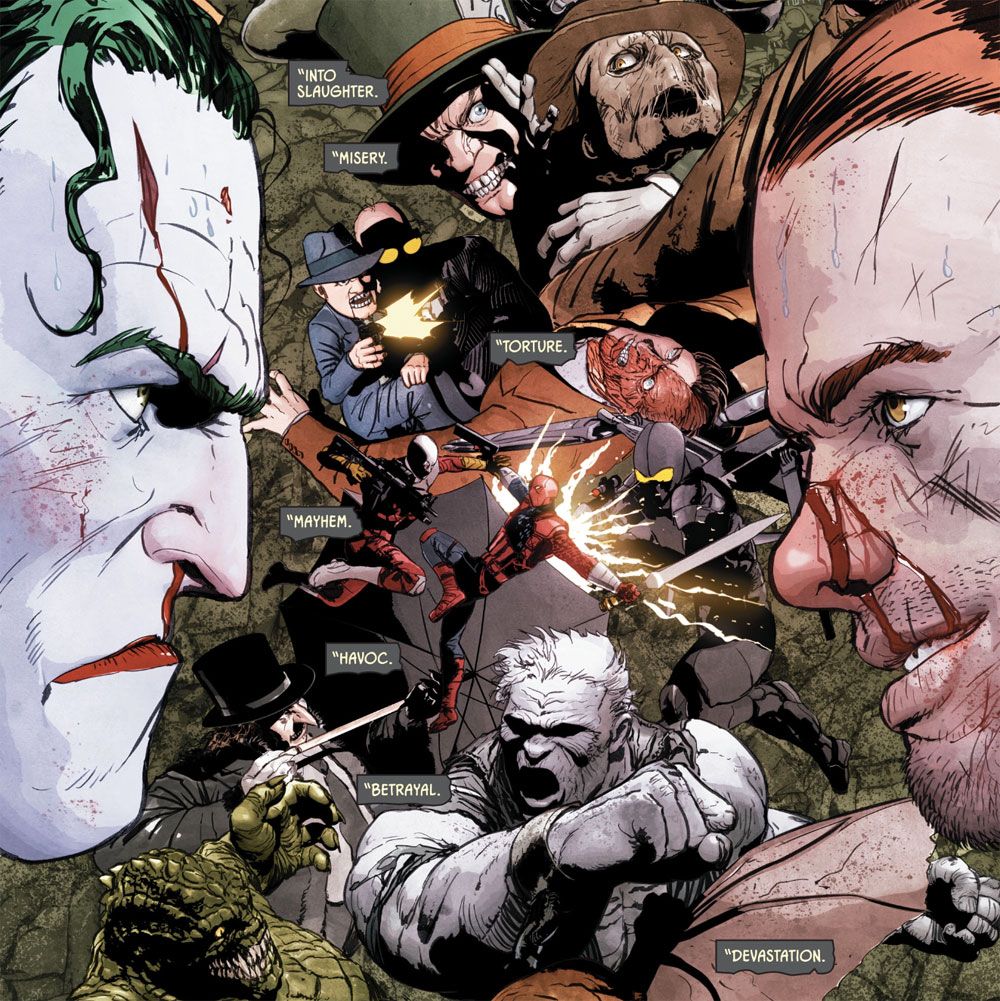SPOILER WARNING: The following article contains major spoilers for Batman #25, on sale now.
Batman #25 kicks off "The War of Jokes and Riddles," Tom King and Miken Janin's new story arc pitting the Joker and Riddler against one another, with all of Gotham City as both battleground and potential casualties. Told in part as a flashback, with Batman trying to explain how this conflict began, the story promises major destruction.
RELATED: EXCLUSIVE - Scott Snyder On The Joker’s Role in Metal, ‘Three Jokers’ Mystery
So, taking a page from Batman's own methods, in order to be best prepared for "The War of Jokes and Riddles," we need to look first at where these characters have been so we can understand their paths moving forward.
The Joke's On You
When DC launched its New 52 reboot back in 2011, the Joker was carefully and deliberately taken off the table for the first year of publication. Detective Comics #1 literally cut the Joker's face off, with no further sign of him for twelve months save for that tattered piece of flesh. (The discarded face, for a time, made appearances courtesy the new version of the deranged character calling herself the Joker's Daughter.) When he finally resurfaced, the Joker assaulted both the Batman and his allies. First, the "Death of the Family" storyline featured the Joker's capturing of the "Batman Family" (Batgirl, Catwoman, Nightwing, Red Hood, Red Robin and Robin) and attempting to damage their trust in Batman to isolate the Dark Knight.
RELATED: Batman Will Reveal His ‘Darkest Secret’ to Catwoman in New Arc
Next, the "Endgame" storyline expanded the Joker's reach, brainwashing the members of the Justice League to attack Batman. Batman's closest allies were once more used as collateral damage, with Alfred's right hand being chopped off and Commissioner Gordon receiving a massive chest wound. It also introduced the idea that the Joker may well be near-immortal, with exposure to a substance called dionesium centuries earlier creating Gotham City's eternal nemesis. While it (yet again) briefly looked like the Joker had perished in this storyline, his interactions with an amnesiac Bruce Wayne in the follow-up storyline "Superheavy" reinforced one of the big revelations from "Endgame," that the Joker knew Batman's secret identity. The Joker's meeting with Bruce Wayne in Batman #47-48 was chilling, in no small part because it brought home the idea that the Joker found no real point in living without Batman's presence to provide a worthy foe, an idea that feeds directly into King and Janin's new storyline.
If that wasn't enough, though, the epic "Darkseid War" storyline in Justice League #41-50 brought a new wrinkle to the Joker. When Batman took command of the Mobius Chair, he asked it for the real name of the Joker. The reply was suitably enigmatic: there are three Jokers. Near the end of DC Universe: Rebirth #1, we got a glimpse of these different Jokers in action; a computer screen in the Bat Cave shows us images of all three, one looking like the original Jerry Robinson depiction of the character, a second giving us Brian Bolland's interpretation from Batman: The Killing Joke, and the third being the most recent, modern incarnation. So far, no further explanation has been provided, but what better place to explain a second or third Joker than in the climax of this storyline? Yes, Geoff Johns is slated to fully explain the three Jokers riddle in Doomsday Clock, but there's no reason King and Janin can't or won't help to lay the groundwork here.
Riddle Me This
The Riddler's New 52 appearances, similar to those of the Joker, have been used sparingly but with great effect. Most of them revolved around the "Zero Year" storyline, the New 52's flashback to the earliest days of Batman and the near-destruction of Gotham City. Riddler begins as an employee of Philip Kane, Bruce's uncle. Right from the start, the Riddler is the proverbial bad egg, believing that the young Bruce should be murdered in order to make Kane look more sympathetic and also prevent Bruce from taking control of Wayne Enterprises. The attempt to kill Bruce (enacted by Riddler himself after Kane refuses) ironically brings the Red Hood Gang into the picture, the leader of whom may or may not have been the man that would become the Joker.
Several years later, with a fully-grown Bruce Wayne becoming Batman, the Riddler once more appears. When a hurricane strikes Gotham City, Riddler takes control of the flooded and powerless wasteland, taunting its residents with a near impossible riddle that had to be solved before technology would be returned. Riddler's schemes ultimately involved not only a massive game board with a series of riddles, but an attempt to make Batman kill himself to save the city. In the end, Riddler was captured and taken to Arkham Asylum.
RELATED: DC Unleashes Evil Versions of Batman in Dark Nights: Metal One-Shots
Riddler did manage to escape from Arkham Asylum, but his various attempts were short-lived. The first escape was actually courtesy the Joker, who gave the Riddler a riddle of his own to solve, with failure equaling death. The reward for solving the riddle was not only life, but briefly serving as a strategist for the Joker during "Death of the Family." Later, when Arkham Asylum residents were briefly housed in Wayne Manor, Riddler managed to avoid being shipped back to Arkham at the end of the stay, hiding within the depths of the Manor before finally being captured by Jim Gordon and locked up once more.
The one aspect of the Riddler that has been emphasized throughout his time in the New 52, though, is his brilliance in problem-solving. Following up on the pre-Flashpoint rendition of the character that for a time had the Riddler using his intellect for good, this version of the character is not only great with puzzles, but is also possessing the ability to think through situations to far-off conclusions. His decision to murder a young Bruce Wayne, while containing more than a touch of sociopathy, is determined because of how Riddler sees public reaction unfolding as a result of the death. He's a long-term planner, one who sees the entire world as a series of puzzles ready to unlock.
When Jokes and Riddles Collide
As the Joker and Riddler square off in Batman #25, one thing is almost immediately clear: over the years, the two villains have drifted into each other's territory. The Joker's methods in Batman #25 involve a pattern of murders across Gotham, with Joker's headquarters determined by looking at the face formed on a map of the deaths. It's less humor and more riddle, something that in the past would have been unheard of for the Joker. It's no small wonder, then, that the Riddler is able to crack the Joker's own riddle long before Batman himself does.
At the same time, the Riddler is involved in some Joker-esque behavior of his own. Here, we learn how the Riddler uses information on the Arkham guards to guarantee his own safety. This feels much more in line with the Joker's methods, a level of terror normally associated with the clown-faced monster. And then, all of it comes to a dangerous confrontation at the end of Batman #25, one that strikes the proverbial match with the powder keg just around the corner.
RELATED: DC’s Outsiders: Batman’s Black-Ops Team, Explained
With this issue being told in flashback, King and Janin are able to tease us what's in store as these two foes square off. With just about all of Batman's major foes promised to appear (including glimpses of Poison Ivy, Mr. Freeze, Mad Hatter, Scarecrow, Scarface, Two-Face, Deadshot, the former KGBeast, Solomon Grundy, Penguin, Killer Croc, Clayface, and Man-Bat), it looks like villains are going to need to choose sides as Joker and Riddler pit them against each other. With some of these characters currently regulars in other titles (Deadshot in Suicide Squad, Clayface in Detective Comics), the possibility of other heroes and villains getting pulled into the conflict feels somewhat inevitable.
Based on this first issue, at stake could not only be Gotham City, but a potential seizing of both villainous portfolios. Or, will both the Joker and Riddler manage to regain control of their own method of attack? "The War of Jokes and Riddles" could be as much about redefining how the two characters operate from a writing standpoint, providing a guide for future creators and how to handle crafting stories around the Riddler or Joker. In the meantime, though, it feels like it's time to sit back and watch the show. With an over-sized first issue and a massive number of popular villains being dragged into the story, "The War of Jokes and Riddles" promises to be a fun ride.




